Differentiation of Soybean Genotypes Concerning Seed Physiological Quality Using Hyperspectral Bands
Abstract
1. Introduction
2. Materials and Methods
2.1. Conducting the Field Experiment
2.2. Spectral Variables Evaluated in Soybean Seeds
2.3. Analysis of the Physiological Quality of Soybean Seeds
2.4. Statistical Analysis
3. Results
4. Discussion
5. Conclusions
Author Contributions
Funding
Data Availability Statement
Conflicts of Interest
References
- CONAB. Acompanhamento Da Safra Brasileira de Grãos; CONAB: Brasília, Brazil, 2022; Volume 10.
- Chen, Z.; Fan, W.; Luo, Z.; Guo, B. Soybean Seed Counting and Broken Seed Recognition Based on Image Sequence of Falling Seeds. Comput. Electron. Agric. 2022, 196, 106870. [Google Scholar] [CrossRef]
- Deng, J.-C.; Li, X.-M.; Xiao, X.-L.; Wu, H.-J.; Yang, C.-Q.; Long, X.-Y.; Zhang, Q.-H.; Nasir, I.; Wang, X.-C.; Yong, T.-W.; et al. Field Mold Stress Induced Catabolism of Storage Reserves in Soybean Seed and the Resulting Deterioration of Seed Quality in the Field. J. Integr. Agric. 2022, 21, 336–350. [Google Scholar] [CrossRef]
- Oliveira, I.C.; Franca, T.; Nicolodelli, G.; Morais, C.P.; Marangoni, B.; Bacchetta, G.; Milori, D.M.B.P.; Alves, C.Z.; Cena, C. Fast and Accurate Discrimination of Brachiaria Brizantha (A.Rich.) Stapf Seeds By Molecular Spectroscopy and Machine Learning. ACS Agric. Sci. Technol. 2021, 1, 443–448. [Google Scholar] [CrossRef]
- Tu, K.; Wen, S.; Cheng, Y.; Zhang, T.; Pan, T.; Wang, J.; Wang, J.; Sun, Q. A Non-Destructive and Highly Efficient Model for Detecting the Genuineness of Maize Variety‘JINGKE 968′ Using Machine Vision Combined with Deep Learning. Comput. Electron. Agric. 2021, 182, 106002. [Google Scholar] [CrossRef]
- Schmitz, P.K.; Kandel, H.J. Using Canopy Measurements to Predict Soybean Seed Yield. Remote Sens. 2021, 13, 3260. [Google Scholar] [CrossRef]
- Zhao, G.; Quan, L.; Li, H.; Feng, H.; Li, S.; Zhang, S.; Liu, R. Real-Time Recognition System of Soybean Seed Full-Surface Defects Based on Deep Learning. Comput. Electron. Agric. 2021, 187, 106230. [Google Scholar] [CrossRef]
- da Silva Junior, C.A.; Nanni, M.R.; Shakir, M.; Teodoro, P.E.; de Oliveira-Júnior, J.F.; Cezar, E.; de Gois, G.; Lima, M.; Wojciechowski, J.C.; Shiratsuchi, L.S. Soybean Varieties Discrimination Using Non-Imaging Hyperspectral Sensor. Infrared Phys. Technol. 2018, 89, 338–350. [Google Scholar] [CrossRef]
- Zhang, H.; Hou, Q.; Luo, B.; Tu, K.; Zhao, C.; Sun, Q. Detection of Seed Purity of Hybrid Wheat Using Reflectance and Transmittance Hyperspectral Imaging Technology. Front. Plant Sci. 2022, 13, 1015891. [Google Scholar] [CrossRef]
- Santana, D.C.; Teodoro, L.P.R.; Baio, F.H.R.; dos Santos, R.G.; Coradi, P.C.; Biduski, B.; da Silva Junior, C.A.; Teodoro, P.E.; Shiratsuchi, L.S. Classification of Soybean Genotypes for Industrial Traits Using UAV Multispectral Imagery and Machine Learning. Remote Sens. Appl. 2023, 29, 100919. [Google Scholar] [CrossRef]
- Prabhakar, M.; Prasad, Y.G.; Rao, M.N. Remote Sensing of Biotic Stress in Crop Plants and Its Applications for Pest Management. In Crop Stress and Its Management: Perspectives and Strategies; Springer: Berlin/Heidelberg, Germany, 2011; pp. 517–545. [Google Scholar]
- Gava, R.; Santana, D.C.; Cotrim, M.F.; Rossi, F.S.; Teodoro, L.P.R.; da Silva Junior, C.A.; Teodoro, P.E. Soybean Cultivars Identification Using Remotely Sensed Image and Machine Learning Models. Sustainability 2022, 14, 7125. [Google Scholar] [CrossRef]
- Santana, D.C.; de Theodoro, G.F.; Gava, R.; de Oliveira, J.L.G.; Teodoro, L.P.R.; de Oliveira, I.C.; Baio, F.H.R.; da Silva Junior, C.A.; de Oliveira, J.T.; Teodoro, P.E. A New Approach to Identifying Sorghum Hybrids Using UAV Imagery Using Multispectral Signature and Machine Learning. Algorithms 2024, 17, 23. [Google Scholar] [CrossRef]
- Ministério da Agricultura. P. e A. Regras Para Análise de Sementes; Ministério da Agricultura: Brasília, Brazil, 2009.
- Vieira, M.; von Pinho, E.V.R. Metodologia Do Teste de Tetrazólio Em Sementes de Algodão. In Vigor de Sementes: Conceitos e Testes; ABRATES: Londrina, Brazil, 1999; pp. 1–8. [Google Scholar]
- França Neto, J.B.; Krzyzanowski, F.C.; da Costa, N.P. O Teste de Tetrazólio Em Sementes de Soja; Embrapa: Londrina, Brazil, 1998; Volume 116. [Google Scholar]
- R Core Team. R: A Language and Environment for Statistical Computing; R Core Team: Vienna, Austria, 2013. [Google Scholar]
- Rossi, R.F.; Cavariani, C.; de Barros França-Neto, J. Vigor de Sementes, População de Plantas e Desempenho Agronômico de Soja. Rev. De CiÊNcias AgrÁRias-Amaz. J. Agric. Environ. Sci. 2017, 60, 215–222. [Google Scholar] [CrossRef][Green Version]
- Santana, D.C.; de Oliveira Cunha, M.P.; dos Santos, R.G.; Cotrim, M.F.; Teodoro, L.P.R.; da Silva Junior, C.A.; Baio, F.H.R.; Teodoro, P.E. High-Throughput Phenotyping Allows the Selection of Soybean Genotypes for Earliness and High Grain Yield. Plant Methods 2022, 18, 13. [Google Scholar] [CrossRef] [PubMed]
- Larios, G.; Nicolodelli, G.; Ribeiro, M.; Canassa, T.; Reis, A.R.; Oliveira, S.L.; Alves, C.Z.; Marangoni, B.S.; Cena, C. Soybean Seed Vigor Discrimination by Using Infrared Spectroscopy and Machine Learning Algorithms. Anal. Methods 2020, 12, 4303–4309. [Google Scholar] [CrossRef]
- Marcos Filho, J. Seed Vigor Testing: An Overview of the Past, Present and Future Perspective. Sci. Agric. 2015, 72, 363–374. [Google Scholar] [CrossRef]
- Moreano, T.B.; Marques, O.J.; Braccini, A.L.; Scapim, C.A.; de França-Neto, J.B.; Krzyzanowski, F.C. Evolution of the Physical and Physiological Quality of Soybean Seeds during Processing. J. Seed Sci. 2018, 40, 313–322. [Google Scholar] [CrossRef]
- Jensen, J.R.; Epiphanio, J.C.N. Sensoriamento Remoto Do Ambiente: Uma Perspectiva Em Recursos Terrestres; Parêntese Editora: São José dos Campos, Brazil, 2009; ISBN 856050706X. [Google Scholar]
- Gebregziabher, B.S.; Zhang, S.; Azam, M.; Qi, J.; Agyenim-Boateng, K.G.; Feng, Y.; Liu, Y.; Li, J.; Li, B.; Sun, J. Natural Variation and Geographical Distribution of Seed Carotenoids and Chlorophylls in 1167 Chinese Soybean Accessions. J. Integr. Agric. 2022, 22, 2632–2647. [Google Scholar] [CrossRef]
- Xie, X.; He, Z.; Chen, N.; Tang, Z.; Wang, Q.; Cai, Y. The Roles of Environmental Factors in Regulation of Oxidative Stress in Plant. BioMed Res. Int. 2019, 2019, 1–11. [Google Scholar] [CrossRef]
- Ravikanth, L.; Jayas, D.S.; White, N.D.G.; Fields, P.G.; Sun, D.-W. Extraction of Spectral Information from Hyperspectral Data and Application of Hyperspectral Imaging for Food and Agricultural Products. Food Bioproc. Technol. 2017, 10, 1–33. [Google Scholar] [CrossRef]
- da Silva Junior, C.A.; Teodoro, P.E.; Teodoro, L.P.R.; Della-Silva, J.L.; Shiratsuchi, L.S.; Baio, F.H.R.; Boechat, C.L.; Capristo-Silva, G.F. Is It Possible to Detect Boron Deficiency in Eucalyptus Using Hyper and Multispectral Sensors? Infrared Phys. Technol. 2021, 116, 103810. [Google Scholar] [CrossRef]
- Tu, K.; Wen, S.; Cheng, Y.; Xu, Y.; Pan, T.; Hou, H.; Gu, R.; Wang, J.; Wang, F.; Sun, Q. A Model for Genuineness Detection in Genetically and Phenotypically Similar Maize Variety Seeds Based on Hyperspectral Imaging and Machine Learning. Plant Methods 2022, 18, 81. [Google Scholar] [CrossRef] [PubMed]
- Xu, P.; Sun, W.; Xu, K.; Zhang, Y.; Tan, Q.; Qing, Y.; Yang, R. Identification of Defective Maize Seeds Using Hyperspectral Imaging Combined with Deep Learning. Foods 2022, 12, 144. [Google Scholar] [CrossRef] [PubMed]
- Sinclair, T.R. Water and Nitrogen Limitations in Soybean Grain Production I. Model Development. Field Crops Res. 1986, 15, 125–141. [Google Scholar] [CrossRef]
- v Chiozza, M.; Parmley, K.A.; Higgins, R.H.; Singh, A.K.; Miguez, F.E. Comparative Prediction Accuracy of Hyperspectral Bands for Different Soybean Crop Variables: From Leaf Area to Seed Composition. Field Crops Res. 2021, 271, 108260. [Google Scholar] [CrossRef]
- Aneece, I.; Thenkabail, P. Accuracies Achieved in Classifying Five Leading World Crop Types and Their Growth Stages Using Optimal Earth Observing-1 Hyperion Hyperspectral Narrowbands on Google Earth Engine. Remote Sens. 2018, 10, 2027. [Google Scholar] [CrossRef]
- Christenson, B.S.; Schapaugh, W.T., Jr.; An, N.; Price, K.P.; Prasad, V.; Fritz, A.K. Predicting Soybean Relative Maturity and Seed Yield Using Canopy Reflectance. Crop Sci. 2016, 56, 625–643. [Google Scholar] [CrossRef]
- Park, B.; Lu, R. Hyperspectral Imaging Technology in Food and Agriculture; Springer: Berlin/Heidelberg, Germany, 2015; Volume 1. [Google Scholar]
- Soares, S.F.C.; Medeiros, E.P.; Pasquini, C.; de Lelis Morello, C.; Galvão, R.K.H.; Araújo, M.C.U. Classification of Individual Cotton Seeds with Respect to Variety Using Near-Infrared Hyperspectral Imaging. Anal. Methods 2016, 8, 8498–8505. [Google Scholar] [CrossRef]
- Huang, M.; He, C.; Zhu, Q.; Qin, J. Maize Seed Variety Classification Using the Integration of Spectral and Image Features Combined with Feature Transformation Based on Hyperspectral Imaging. Appl. Sci. 2016, 6, 183. [Google Scholar] [CrossRef]
- Zhou, Q.; Huang, W.; Fan, S.; Zhao, F.; Liang, D.; Tian, X. Non-Destructive Discrimination of the Variety of Sweet Maize Seeds Based on Hyperspectral Image Coupled with Wavelength Selection Algorithm. Infrared Phys. Technol. 2020, 109, 103418. [Google Scholar] [CrossRef]
- Reddy, P.; Guthridge, K.M.; Panozzo, J.; Ludlow, E.J.; Spangenberg, G.C.; Rochfort, S.J. Near-Infrared Hyperspectral Imaging Pipelines for Pasture Seed Quality Evaluation: An Overview. Sensors 2022, 22, 1981. [Google Scholar] [CrossRef]
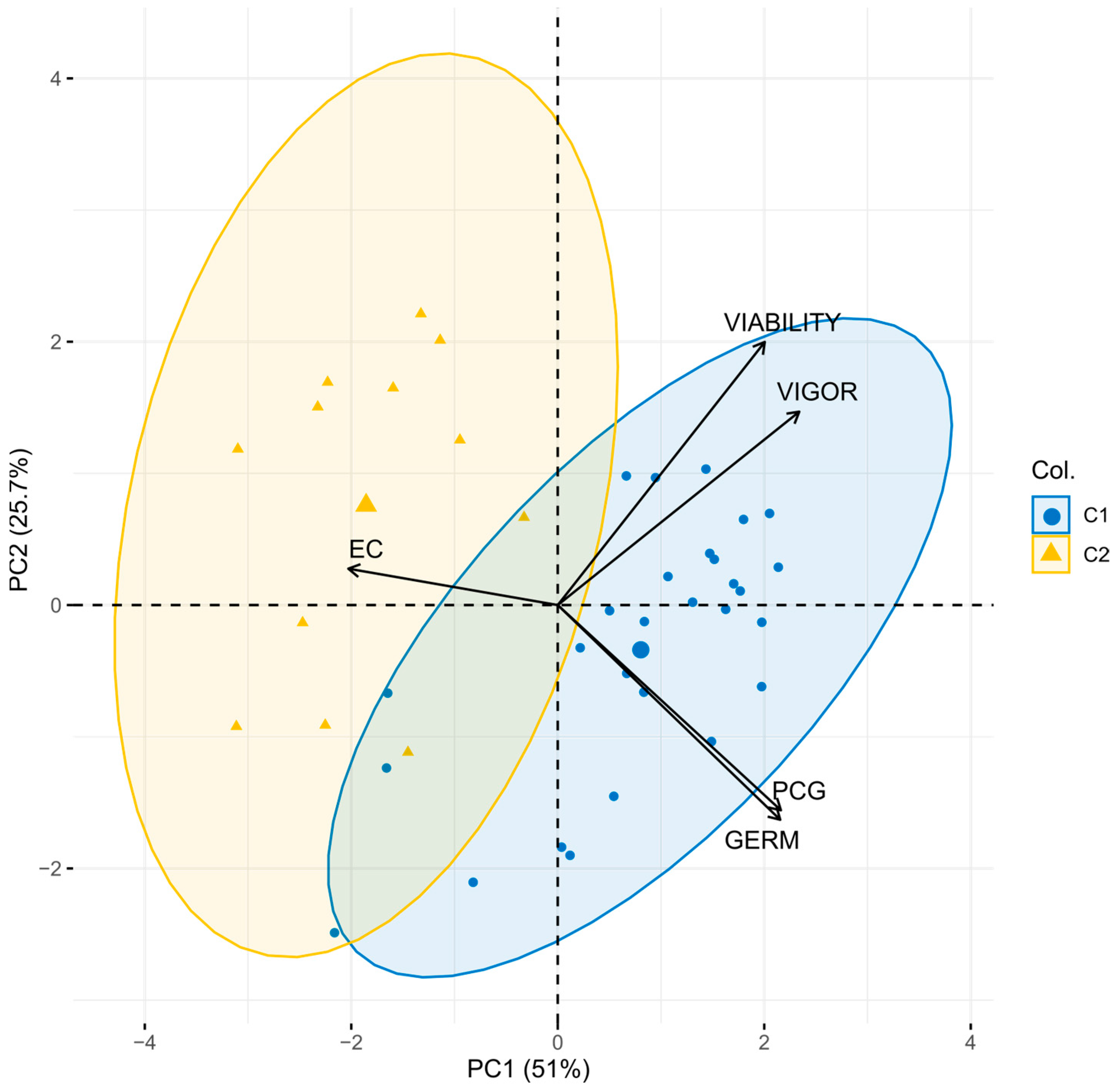
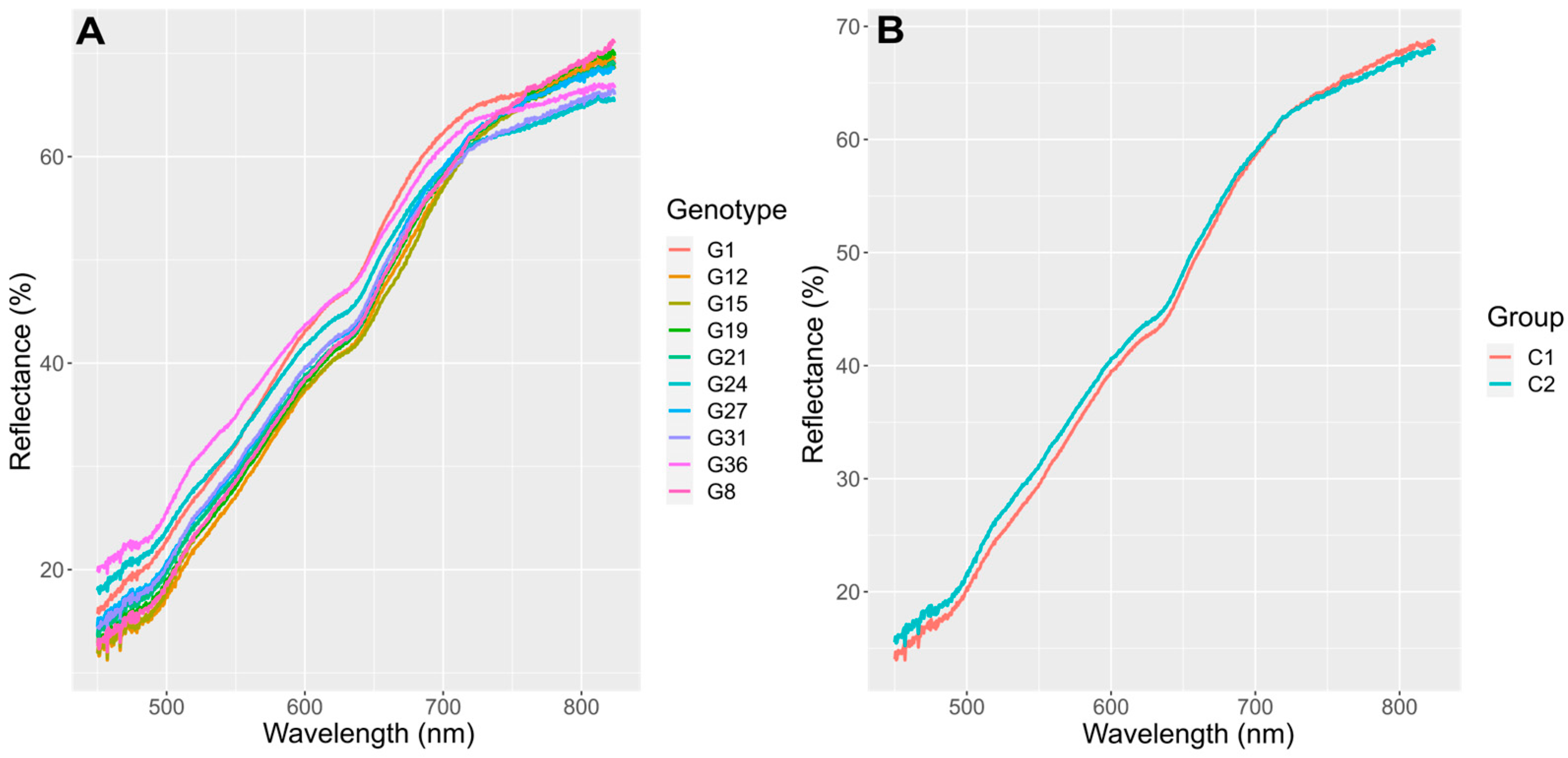
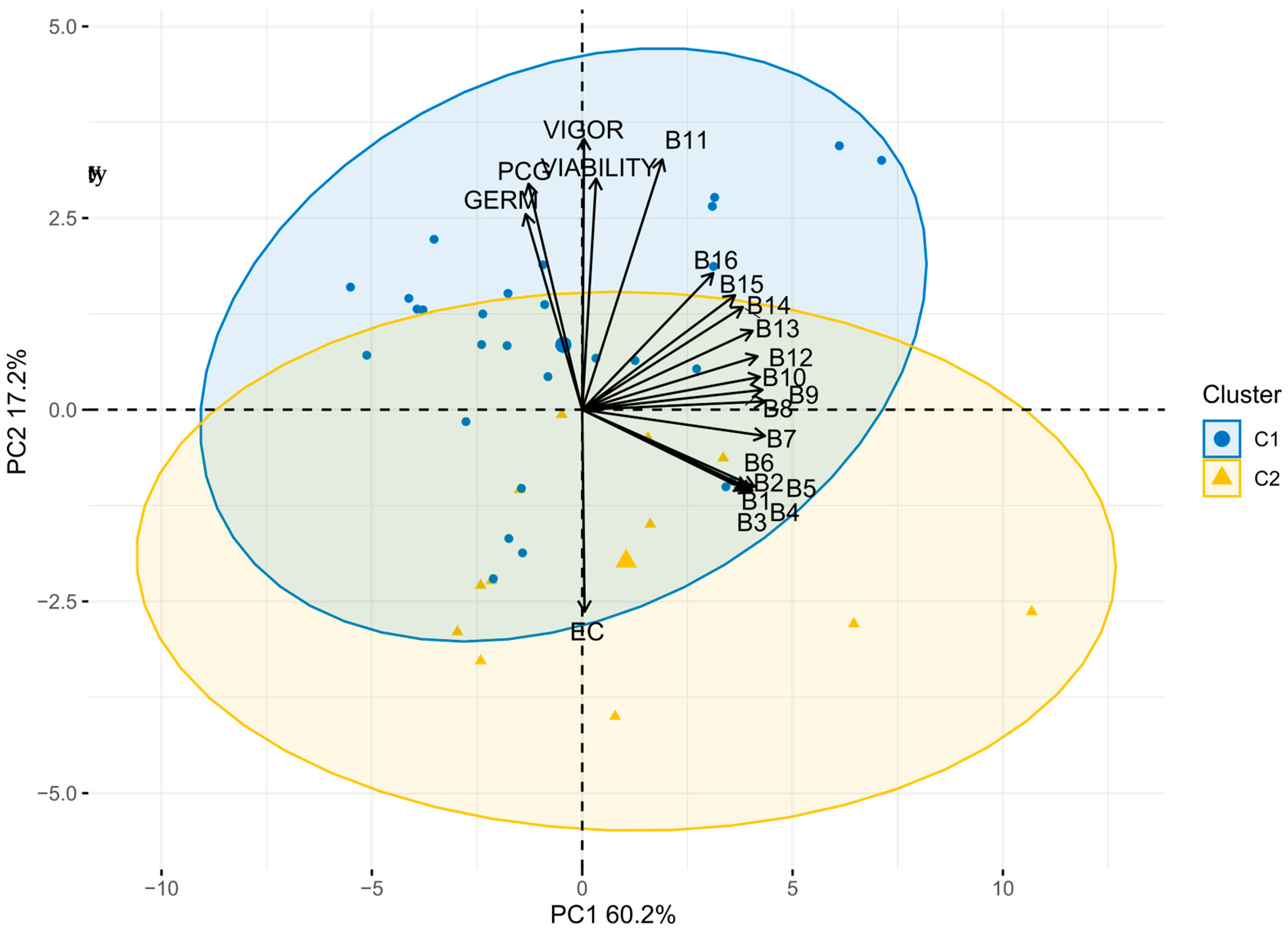
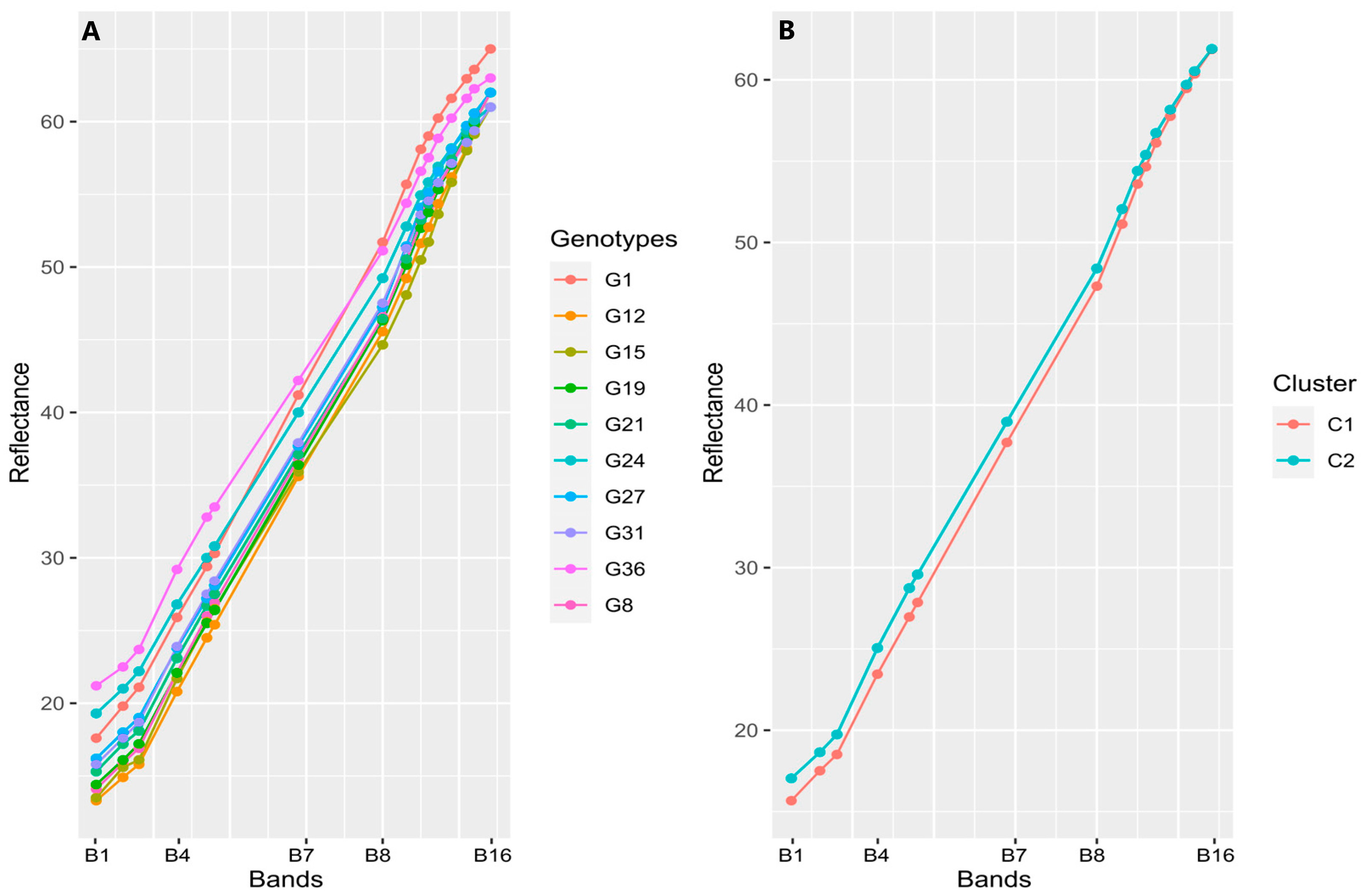
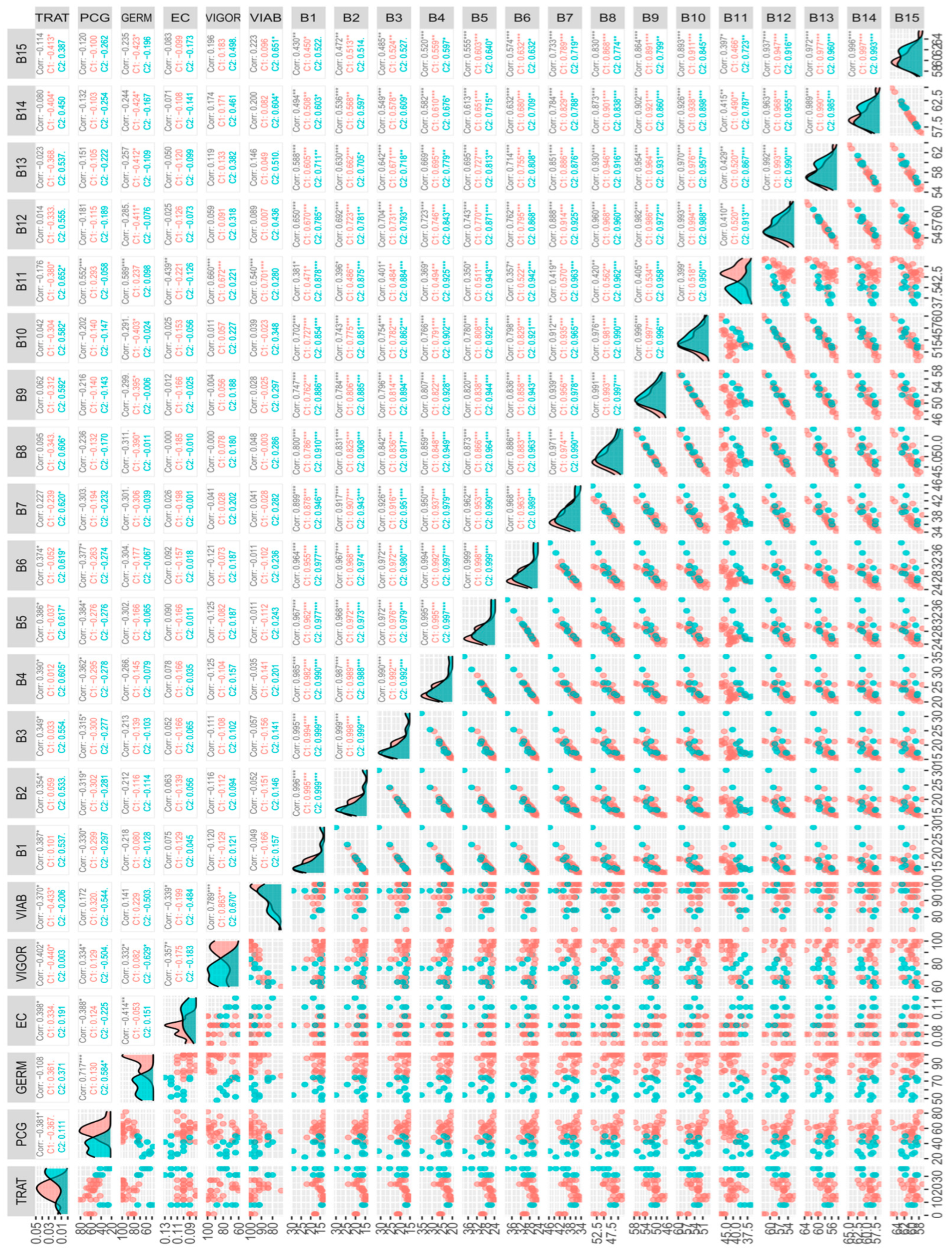
| Bands (No.) | Spectral Range (nm) | Mean Wavelength (nm) |
|---|---|---|
| B1 | 450–475 | 462.5 |
| B2 | 480 | 480 |
| B3 | 481–500 | 490.47 |
| B4 | 501–530 | 515.34 |
| B5 | 531–539 | 534.89 |
| B6 | 540 | 540 |
| B7 | 541–649 | 594.80 |
| B8 | 650 | 650 |
| B9 | 661–670 | 665.54 |
| B10 | 675 | 675 |
| B11 | 676–684 | 680.05 |
| B12 | 685–689 | 686.35 |
| B13 | 690–700 | 695.07 |
| B14 | 701–709 | 705.03 |
| B15 | 710 | 710 |
| B16 | 711–730 | 720.60 |
| FV | GL | PCG | GERM | EC | Tetrazolium | ||
|---|---|---|---|---|---|---|---|
| Vigor | Viability | ||||||
| Treatment | 9 | 602.23 * | 929.12 * | 0.00026 * | 591.11 * | 131.73 * | |
| Waste | 30 | 74.23 | 64.03 | 0.0001 | 73.33 | 22.93 | |
| CV (%) | 16.68 | 9.6 | 10.03 | 10.44 | 5.13 | ||
| FV | GL | B1 | B2 | B3 | B4 | B5 | |
| Treatment | 9 | 27.35 * | 26.16 * | 28.12 * | 27.98 * | 25.44 * | |
| Waste | 30 | 5.0367 | 4.635 | 4.51 | 3.52 | 2.81 | |
| CV (%) | 13.95 | 12.09 | 11.25 | 7.84 | 6.1 | ||
| FV | GL | B6 | B7 | B8 | B9 | B10 | |
| Treatment | 9 | 24.31 * | 20.97 * | 21.76 * | 21.34 * | 20.01 * | |
| Waste | 30 | 2.73 | 2.22 | 2.44 | 2.39 | 2.31 | |
| CV (%) | 5.82 | 3.91 | 3.28 | 3.01 | 2.82 | ||
| FV | GL | B11 | B12 | B13 | B14 | B15 | B16 |
| Treatment | 9 | 21 * | 15.84 * | 12.73 * | 9.81 * | 8.04 * | 5.81 * |
| Waste | 30 | 2.36 | 2.19 | 2.12 | 2.1 | 2.02 | 2.06 |
| CV (%) | 3.86 | 2.63 | 2.52 | 2.43 | 2.35 | 2.32 | |
| Treatment | PCG | GERM | EC | Tetrazolium | |
|---|---|---|---|---|---|
| Vigor | Viability | ||||
| G1 | 61.0 a | 83.0 a | 0.09 a | 98 a | 99 a |
| G8 | 33.0 c | 57.0 c | 0.10 a | 74 b | 95 a |
| G12 | 67.0 a | 94.0 a | 0.10 a | 94 a | 99 a |
| G15 | 60.5 a | 97.5 a | 0.09 a | 92 a | 99 a |
| G19 | 56.5 a | 86.0 a | 0.09 a | 85 a | 90 b |
| G21 | 59.5 a | 93.0 a | 0.10 a | 65 b | 87 b |
| G24 | 52.0 a | 91.0 a | 0.10 a | 75 b | 89 b |
| G27 | 52.5 a | 99.5 a | 0.10 a | 93 a | 96 a |
| G31 | 44.5 b | 72.5 b | 0.11 a | 65 b | 83 b |
| G36 | 30.0 c | 60.0 c | 0.11 a | 79 b | 97 a |
| Treatment | B1 | B2 | B3 | B4 | B5 | B6 | B7 | B8 |
| G1 | 17.6 a | 19.8 a | 21.1 a | 25.9 b | 29.4 b | 30.4 b | 41.2 a | 51.7 a |
| G8 | 14.1 b | 15.9 b | 16.9 b | 22.1 c | 26.0 c | 26.9 c | 36.8 b | 46.6 b |
| G12 | 13.3 b | 14.9 b | 15.8 b | 20.8 c | 24.5 c | 25.4 c | 35.6 b | 45.6 b |
| G15 | 13.5 b | 15.1 b | 16.2 b | 21.7 c | 25.6 c | 26.5 c | 36.0 b | 44.7 b |
| G19 | 14.4 b | 16.1 b | 17.2 b | 22.0 c | 25.5 c | 26.4 c | 36.4 b | 46.3 b |
| G21 | 15.3 b | 17.2 b | 18.1 b | 23.1 c | 26.7 c | 27.6 c | 37.1 b | 46.5 b |
| G24 | 19.4 a | 21.0 a | 22.3 a | 26.8 b | 30.0 b | 30.8 b | 40.0 a | 49.2 a |
| G27 | 16.3 b | 18.1 b | 19.0 b | 23.8 c | 27.2 c | 28.2 c | 37.8 b | 47.25 b |
| G31 | 15.8 b | 17.6 b | 18.7 b | 23.9 c | 27.5 c | 28.4 c | 37.9 b | 47.5 b |
| G36 | 21.2 a | 22.5 a | 23.7 a | 29.3 a | 32.8 a | 33.4 a | 42.2 a | 51.1 a |
| Treatment | B9 | B10 | B11 | B12 | B13 | B14 | B15 | B16 |
| G1 | 55.7 a | 58.1 a | 43.4 a | 60.3 a | 61.6 a | 63.0 a | 63.6 a | 64.6 a |
| G8 | 50.5 b | 53.0 c | 35.6 c | 55.6 b | 57.1 b | 59.0 b | 60.0 b | 61.6 b |
| G12 | 49.2 b | 51.7 d | 40.9 a | 54.3 b | 56.2 b | 58.2 b | 59.2 b | 61.0 b |
| G15 | 48.1 b | 50.5 d | 40.6 a | 53.6 b | 55.9 b | 58.0 b | 59.1 b | 61.0 b |
| G19 | 50.2 b | 52.7 c | 39.2 b | 55.3 b | 57.0 b | 58.9 b | 59.9 b | 61.6 b |
| G21 | 50.6 b | 53.2 c | 38.9 b | 55.8 b | 57.4 b | 59.2 b | 60.1 b | 61.8 b |
| G24 | 52.8 a | 54.9 b | 41.0 a | 56.9 b | 58.2 b | 59.4 b | 60.1 b | 61.0 b |
| G27 | 51.4 b | 54.1 c | 41.7 a | 56.5 b | 58.1 b | 59.7 b | 60.6 b | 62.1 b |
| G31 | 51.3 b | 53.6 c | 36.9 c | 55.8 b | 57.1 b | 58.6 b | 59.4 b | 60.7 b |
| G36 | 54.4 a | 56.6 a | 39.7 b | 58.9 a | 60.3 a | 61.6 a | 62.2 a | 63.3 a |
Disclaimer/Publisher’s Note: The statements, opinions and data contained in all publications are solely those of the individual author(s) and contributor(s) and not of MDPI and/or the editor(s). MDPI and/or the editor(s) disclaim responsibility for any injury to people or property resulting from any ideas, methods, instructions or products referred to in the content. |
© 2024 by the authors. Licensee MDPI, Basel, Switzerland. This article is an open access article distributed under the terms and conditions of the Creative Commons Attribution (CC BY) license (https://creativecommons.org/licenses/by/4.0/).
Share and Cite
Oliveira, I.C.d.; Santana, D.C.; Romancini, V.T.; Seron, A.C.d.S.C.; Alves, C.Z.; Coradi, P.C.; Júnior, C.A.d.S.; Santos, R.G.d.; Baio, F.H.R.; Teodoro, P.E.; et al. Differentiation of Soybean Genotypes Concerning Seed Physiological Quality Using Hyperspectral Bands. AgriEngineering 2024, 6, 4752-4765. https://doi.org/10.3390/agriengineering6040272
Oliveira ICd, Santana DC, Romancini VT, Seron ACdSC, Alves CZ, Coradi PC, Júnior CAdS, Santos RGd, Baio FHR, Teodoro PE, et al. Differentiation of Soybean Genotypes Concerning Seed Physiological Quality Using Hyperspectral Bands. AgriEngineering. 2024; 6(4):4752-4765. https://doi.org/10.3390/agriengineering6040272
Chicago/Turabian StyleOliveira, Izabela Cristina de, Dthenifer Cordeiro Santana, Victoria Toledo Romancini, Ana Carina da Silva Cândido Seron, Charline Zaratin Alves, Paulo Carteri Coradi, Carlos Antônio da Silva Júnior, Regimar Garcia dos Santos, Fábio Henrique Rojo Baio, Paulo Eduardo Teodoro, and et al. 2024. "Differentiation of Soybean Genotypes Concerning Seed Physiological Quality Using Hyperspectral Bands" AgriEngineering 6, no. 4: 4752-4765. https://doi.org/10.3390/agriengineering6040272
APA StyleOliveira, I. C. d., Santana, D. C., Romancini, V. T., Seron, A. C. d. S. C., Alves, C. Z., Coradi, P. C., Júnior, C. A. d. S., Santos, R. G. d., Baio, F. H. R., Teodoro, P. E., & Teodoro, L. R. (2024). Differentiation of Soybean Genotypes Concerning Seed Physiological Quality Using Hyperspectral Bands. AgriEngineering, 6(4), 4752-4765. https://doi.org/10.3390/agriengineering6040272












